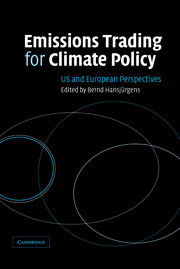Book contents
- Frontmatter
- Contents
- List of figures
- List of tables
- List of contributors
- Preface
- List of abbreviations
- 1 Introduction
- Part 1 Regulatory instruments for climate policy: theoretical aspects
- Part 2 The US approach to pollution control: lessons for climate policy
- Part 3 European policies to control greenhouse gases: the EU directive on emissions trading
- 9 Regulation or coordination: European climate policy between Scylla and Charybdis
- 10 Lobbying and CO2 trade in the EU
- 11 Greenhouse gas emissions trading in the EU: building the world's largest cap-and-trade scheme
- 12 Legal aspects of the European Emissions Trading Scheme
- 13 Emissions trading schemes in Europe: linking the EU Emissions Trading Scheme with national programs
- 14 Concluding observations
- Index
- References
11 - Greenhouse gas emissions trading in the EU: building the world's largest cap-and-trade scheme
Published online by Cambridge University Press: 22 September 2009
- Frontmatter
- Contents
- List of figures
- List of tables
- List of contributors
- Preface
- List of abbreviations
- 1 Introduction
- Part 1 Regulatory instruments for climate policy: theoretical aspects
- Part 2 The US approach to pollution control: lessons for climate policy
- Part 3 European policies to control greenhouse gases: the EU directive on emissions trading
- 9 Regulation or coordination: European climate policy between Scylla and Charybdis
- 10 Lobbying and CO2 trade in the EU
- 11 Greenhouse gas emissions trading in the EU: building the world's largest cap-and-trade scheme
- 12 Legal aspects of the European Emissions Trading Scheme
- 13 Emissions trading schemes in Europe: linking the EU Emissions Trading Scheme with national programs
- 14 Concluding observations
- Index
- References
Summary
Introduction
Economists regard control of greenhouse gas emissions as a natural application for tradable allowances. While the most important existing cap-and-trade scheme – the Sulfur Allowance Scheme in the United States – is largely based on the notion that location does matter, greenhouse gases are uniformly mixed pollutants at the global scale, i.e. the time and place of the emissions does not matter from an environmental point of view. At the same time it is relatively uncontroversial, although subject to some scientific uncertainty, to fix conversion rates between the different greenhouse gases, thereby enabling the establishment of an emissions trading scheme for all greenhouse gases.
However, the framing of international climate change policy – most importantly in setting targets – is a crucial precondition for the implementation of cap-and-trade allowance schemes. This process has turned out to be very cumbersome so far and has rendered a global company-based greenhouse gas emissions trading scheme a distant objective. While climate change was put on the radar screen as a major environmental problem some two decades ago, the incomplete international institutional governance structure has so far allowed only limited progress. The UN Framework Convention on Climate Change, agreed in 1992, contains only non-binding commitments for the industrialized world. The Kyoto Protocol, agreed in 1997, contains legally binding targets for the same set of countries plus the transition economies in Central and Eastern Europe and some successor countries of the former Soviet Union.
- Type
- Chapter
- Information
- Emissions Trading for Climate PolicyUS and European Perspectives, pp. 162 - 176Publisher: Cambridge University PressPrint publication year: 2005
References
- 5
- Cited by



